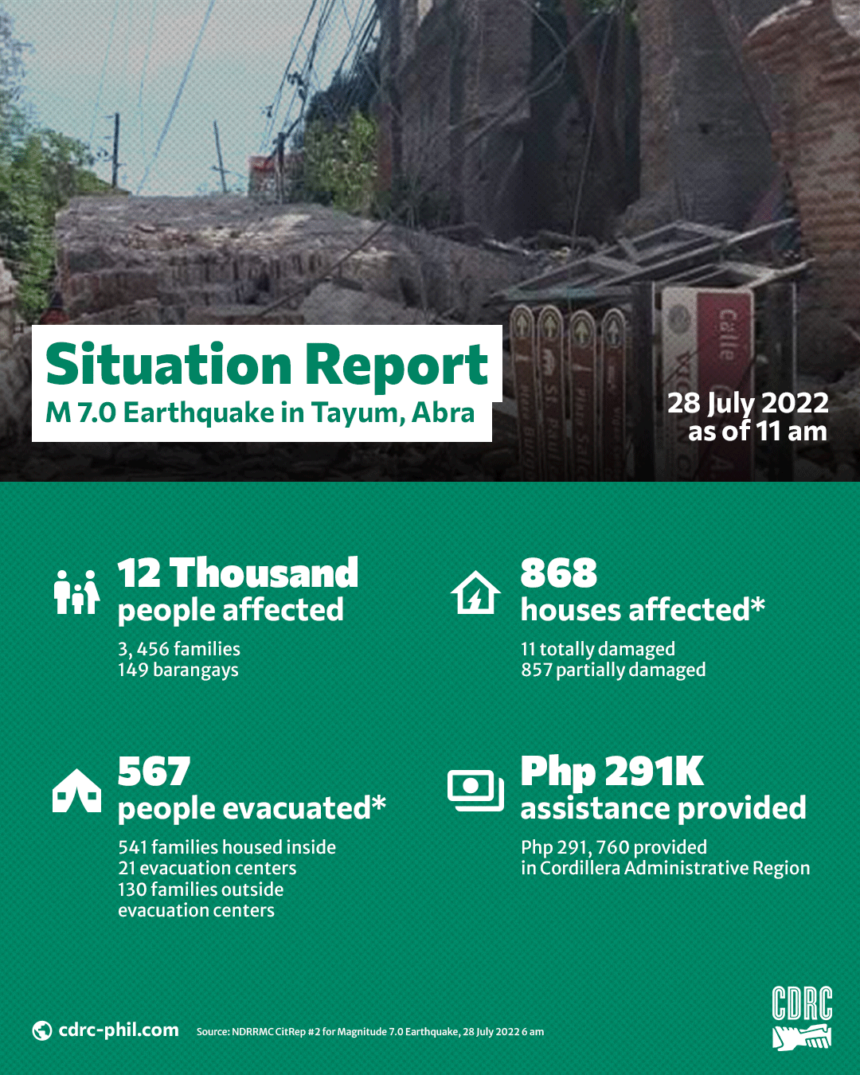Situation Overview
A 7. 3 magnitude earthquake was recorded yesterday at around 8:43 in the morning in Lagangilang, Abra in Cordillera Region. Its impact was also experienced in other surrounding areas in Northern Luzon as well as the National Capital Region. The Philippines Institute of Volcanology and Seismology (Phivolcs) later revised the magnitude to 7.0 after further analysis. Still, the earthquake was the strongest to have hit the Philippines in years. An hour after the report, PHIVOLCS recorded several areas in Ilocos Sur with a reported Intensity of V and above.
Intensity VI – Ilocos Sur (Vigan City, Sinait, Bantay, San Esteban); Pangasinan (Laoac) and Benguet (Baguio City)
Intensity V – Ilocos Sur (Magsingal, San Juan); Pangasinan (Alaminos City and Labrador), etc.
As the 7-magnitude quake was centered in the mountainous province of Abra, it set off landslides and caused extensive damage. The Ilocos Center for Research, Empowerment, and Development (ICRED) recorded several reports of infrastructure damage on the ground. In Vigan City, Intensity VI-VII was felt, destroying churches, houses, and other establishments. Light and semi-concrete residences were destroyed or partially damaged while heritage churches and buildings also obtained partial damage including Vigan Cathedral and Bantay Bell Tower. Roads within the city were crumpled and damaged as debris from various infrastructures was scattered by the strong tremors. Several vehicles were also destroyed in the process.
Electricity and water supply in the city were also affected by the earthquake. Powerlines were cut off due to collapsed structures while water supply became unusable as water coming from house faucet were dirty. Other than this, commercial establishments including the public market were closed as LGU officials conducted infrastructures assessments. With this, food and other important things needed by the affected populations are somewhat affected.
In the assessment conducted by the ICRED, ame situation was also reported in different municipalities including Sto. Domingo, Banayoyo, Santa, Santiago, San Esteban, San Juan, where houses, roads and other infrastructures were also partially or totally damaged. Tremors were also felt in Ilocos Norte and La Union which resulted in some minor damages to infrastructure. Some district hospitals were also partially damaged during the earthquake.
Banaoang bridge which connects the Manila North Road across Santa and Bantay in Ilocos Sur is now closed for infrastructure integrity assessment. Affected LGUs also declared an indefinite suspension of classes at all levels and work in both the public and private sectors.
Meanwhile, in the initial report provided by our regional center Cordillera Disaster Response and Development Services, Inc (CORDIS-RDS), all the provinces in the Cordillera Region also felt the strong tremor, particularly in La Trinidad town in Benguet Province which is also one of the worst hit by the 7-magnitude earthquake. There are reports of casualties and damage to roads, shelters, schools, and buildings. Power interruption in some areas is also reported. Strong rains are being experienced in the municipalities of Malibcon and Licuan-Baay which is feared could trigger a landslide.
Widespread power supply interruptions were also reported in some parts of Baguio City, Benguet, Mt. Province, and parts of Kalinga Province. Affected provinces suspended work and classes for both public and private agencies as LGUs are conducting infrastructure assessments. According to Renato Solidum, director of the state seismology agency, the 7-magnitude earthquake was followed by more than 200 aftershocks, thus, strong aftershocks are still expected. Meanwhile, thousands of employees particularly in Quezon City evacuated their offices due to the strong tremors experienced in several parts of Metro Manila.
As of this writing, our two regional centers (CORDIS and ICRED) continue in conducting a more detailed assessment to process to assist in streamlining relief efforts in the affected areas, especially in the remote or hard-to-reach affected communities.
Source: Philippine Institute of Volcanology and Seismology (PHILVOLCS-DOST), Ilocos Center for Research, Empowerment, and Development, Cordillera Disaster Response and Development Services
Affected Populations
According to the Department of Public Works and Highways, the powerful earthquake also resulted in 14 national roads in the province of Abra and the Cordillera Administrative Region (CAR) being impassable.
In the initial data transmitted by the CORDIS-RDS, 24 families of 138 individuals are currently staying in the evacuation center in Tandiangan, National Housing Authority in Benguet. A total of 23 houses sustained damage in Tuba Benguet while one was totally destroyed in La Trinidad. A total of 13 schools were reported to have sustained damages.
The following reports were provided by the National Disaster Risks Reduction Management and Councils (NDRRMC).
• A Total of 1,248 individuals were pre-emptively evacuated.
• At least five people died, two people were killed in Benguet province; one in Abra province; and one more in another province, while 64 individuals were reportedly injured.
Emergency Response Efforts
• CDRC along with its regional center on the ground continues to monitor the situation and has begun issuing situation reports. CorDis–RDS and ICRED immediately activated their emergency response protocols and started data gathering (DNCA).
• Regional centers ICRED and CORDISrDS have deployed their rapid assessment teams to conduct damages, needs and capacity assessment (DNCA) The gathered assessment data and results are now being used to develop an appeal in able to reach a wide range of affected communities through direct emergency relief assistance.
Resources Available
• Standby emergency funds
• Prepositioned goods at the CDRC warehouse
• Monetary and in-kind donations
Expressed Needs
Initial Assessments have indicated immediate needs include;
• Food supplies
• Clean water
• Hygiene kits
• Facemasks
• Primary medicines
• Sleeping materials
• Shelter kit
Coordination
Regional Center
1. Ilocos Center for Research, Empowerment, and Development, Inc. (ICRED)
2. Cordillera Disaster Response and Development Services, Inc. (CorDis-RDS)
Partners
3. National Alliance for Filipino Concerns (NAFCON USA)
4. Foundation for Philippine Progress, Inc.
5. Disaster Risk Reduction Network Philippines (DRRNetPhils)
6. iVolunteer Philippines
7. Diakonie Katastrophenhilfe
Contacts
1. Hanna Fiel, Deputy Executive Director, 0945-8355589, hanna.fiel.cdrc2019@gmail.com
2. Cora Jazmines, Local Partnerships Department, 0928-182-4969, lpd@cdrc-phil.com
Copy of Situation Report available for download: M7.0-EQ-in-Abra-Situation-Report-1-28-July-2022-2.pdf (156 downloads )

